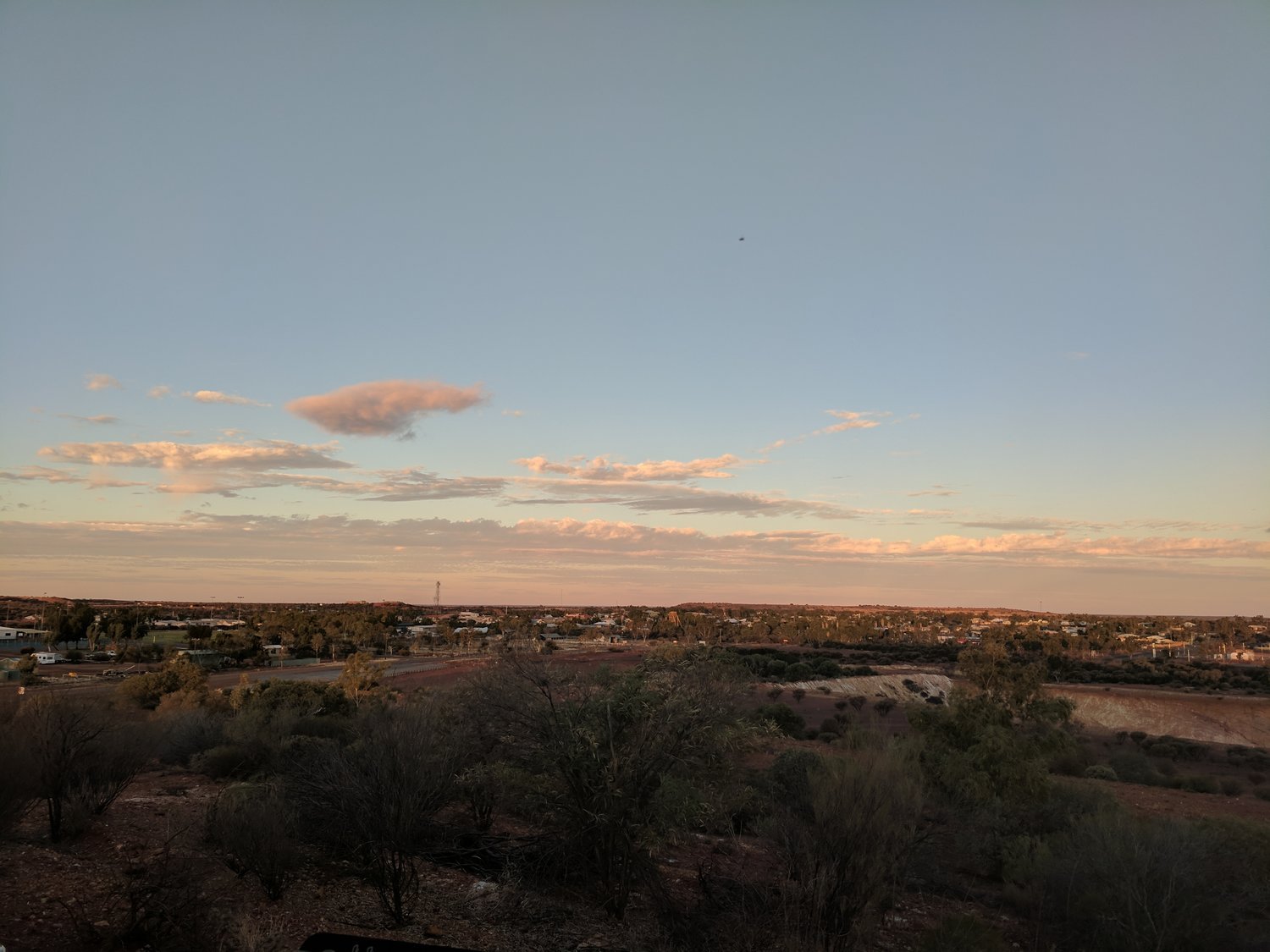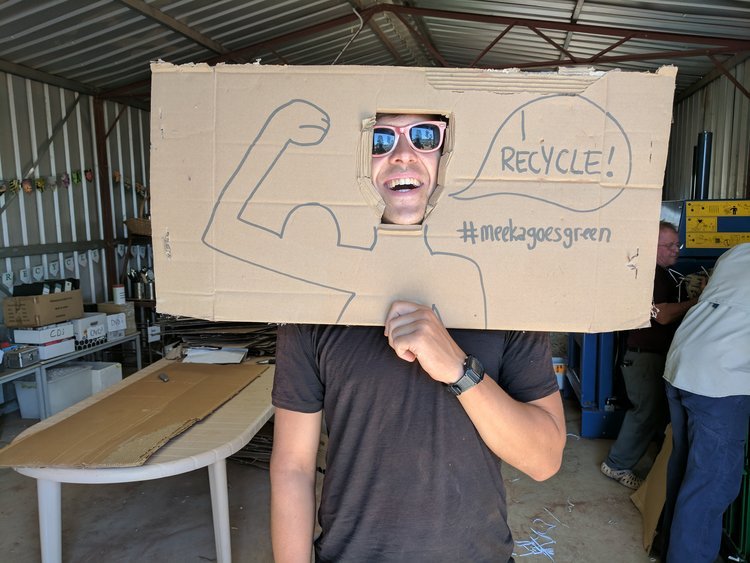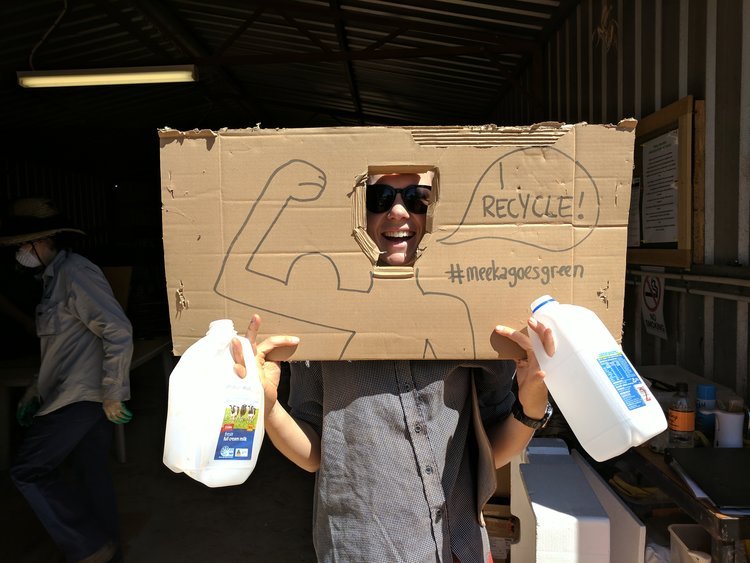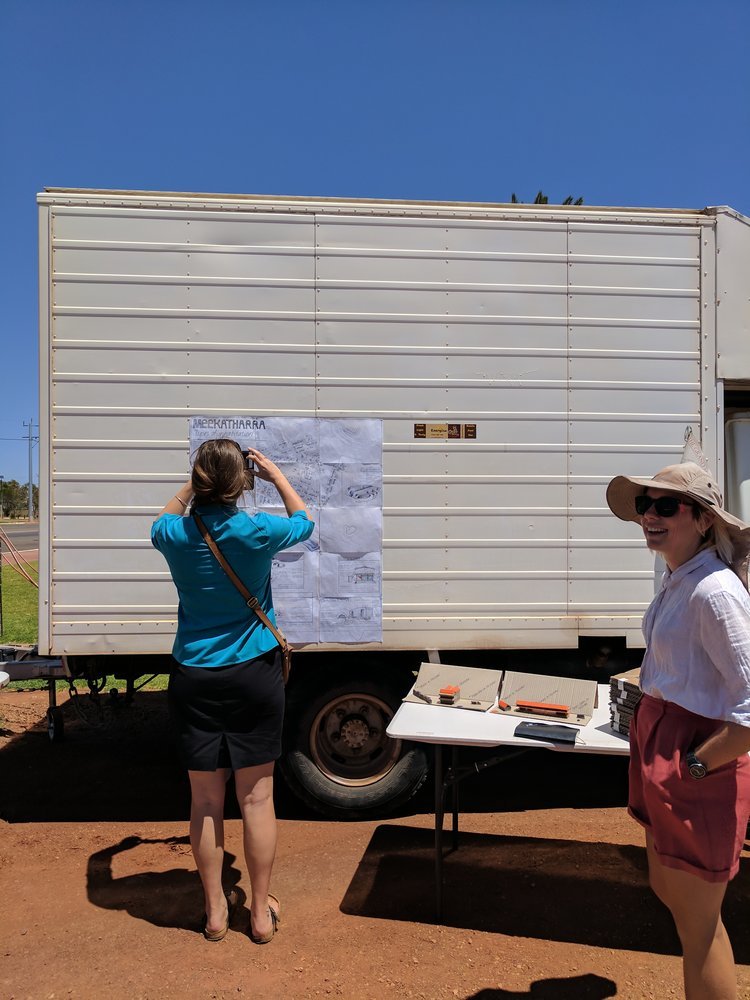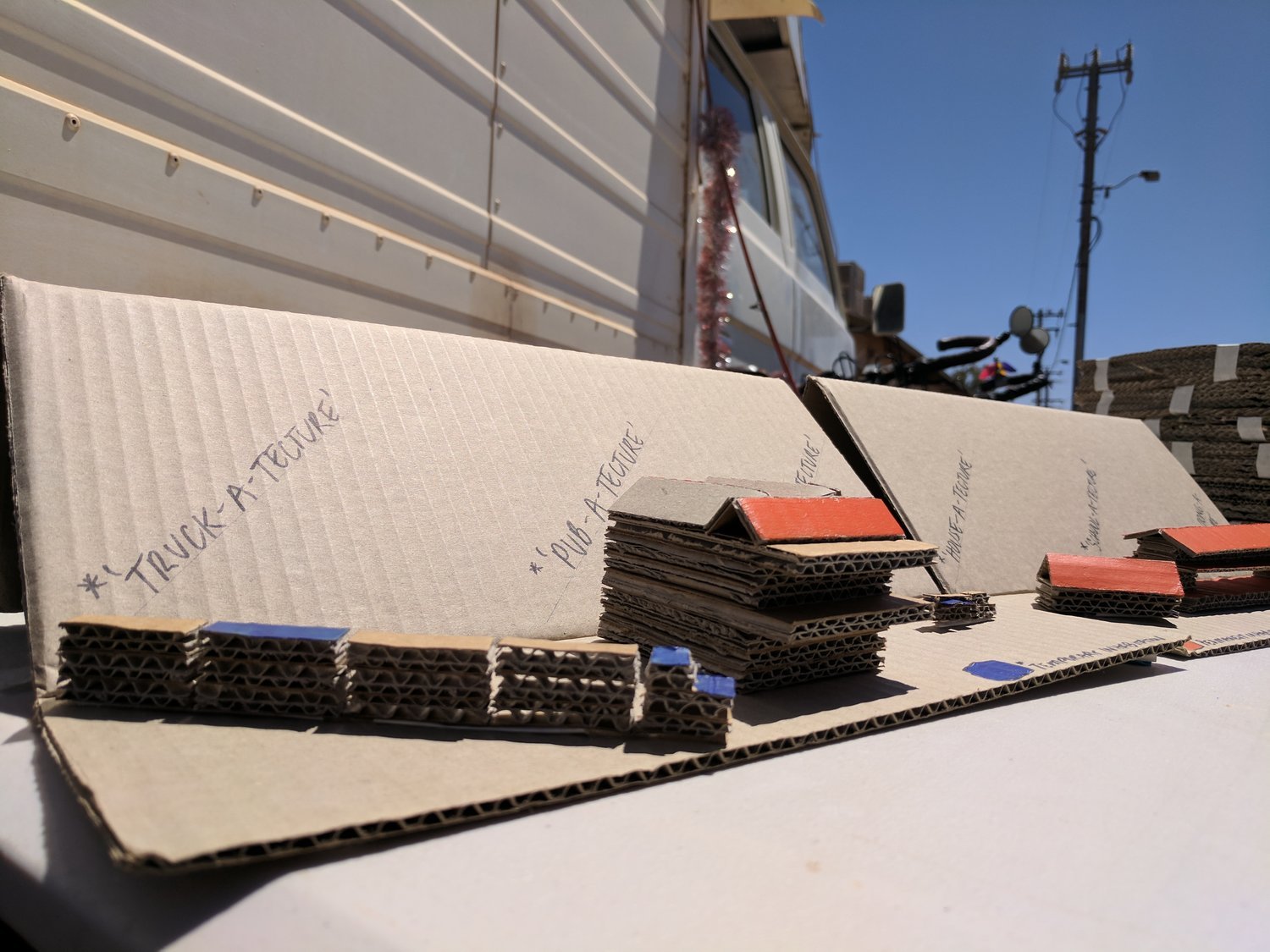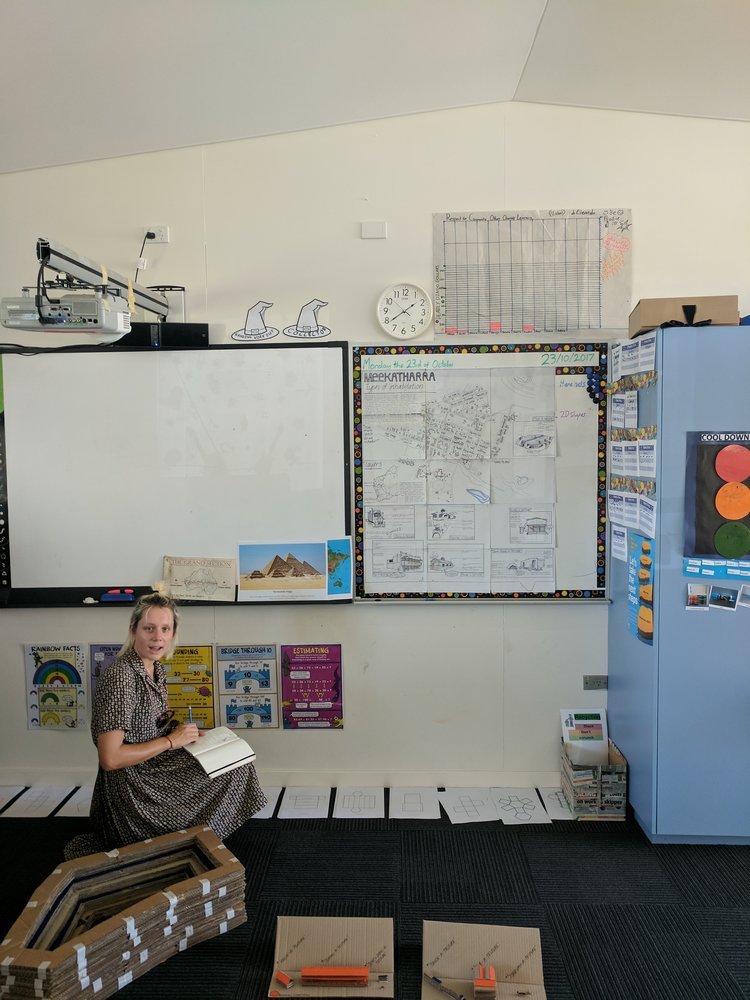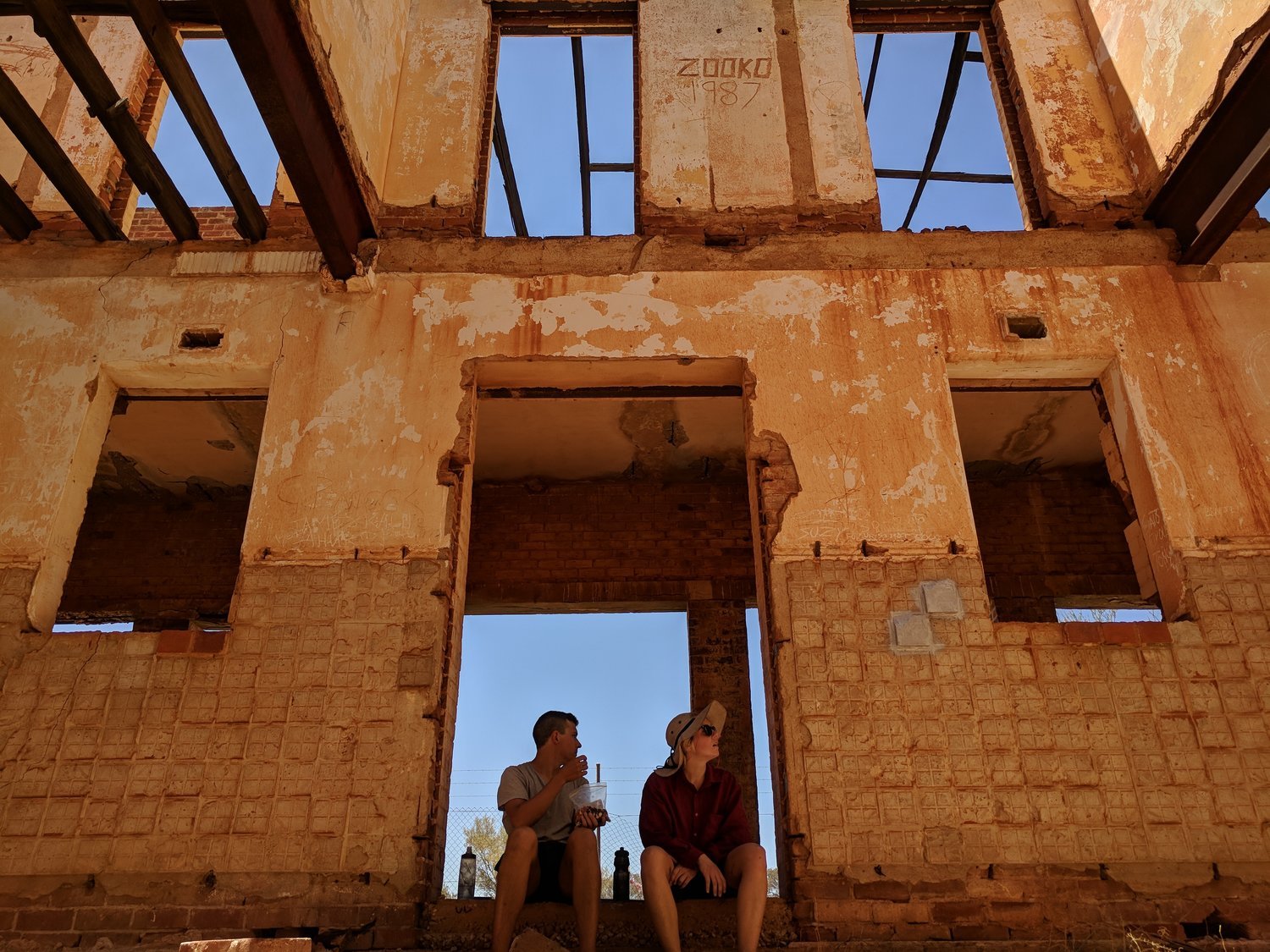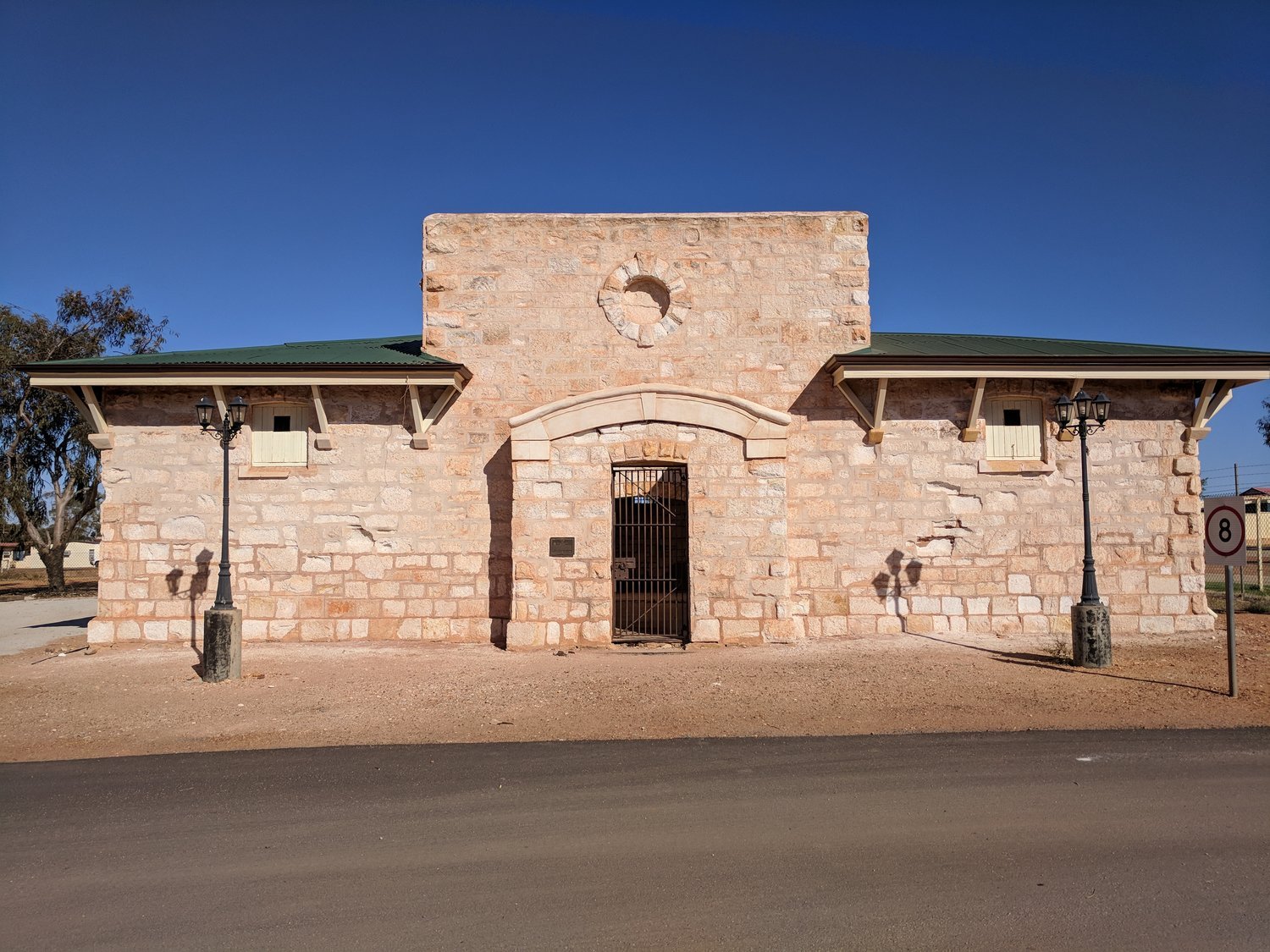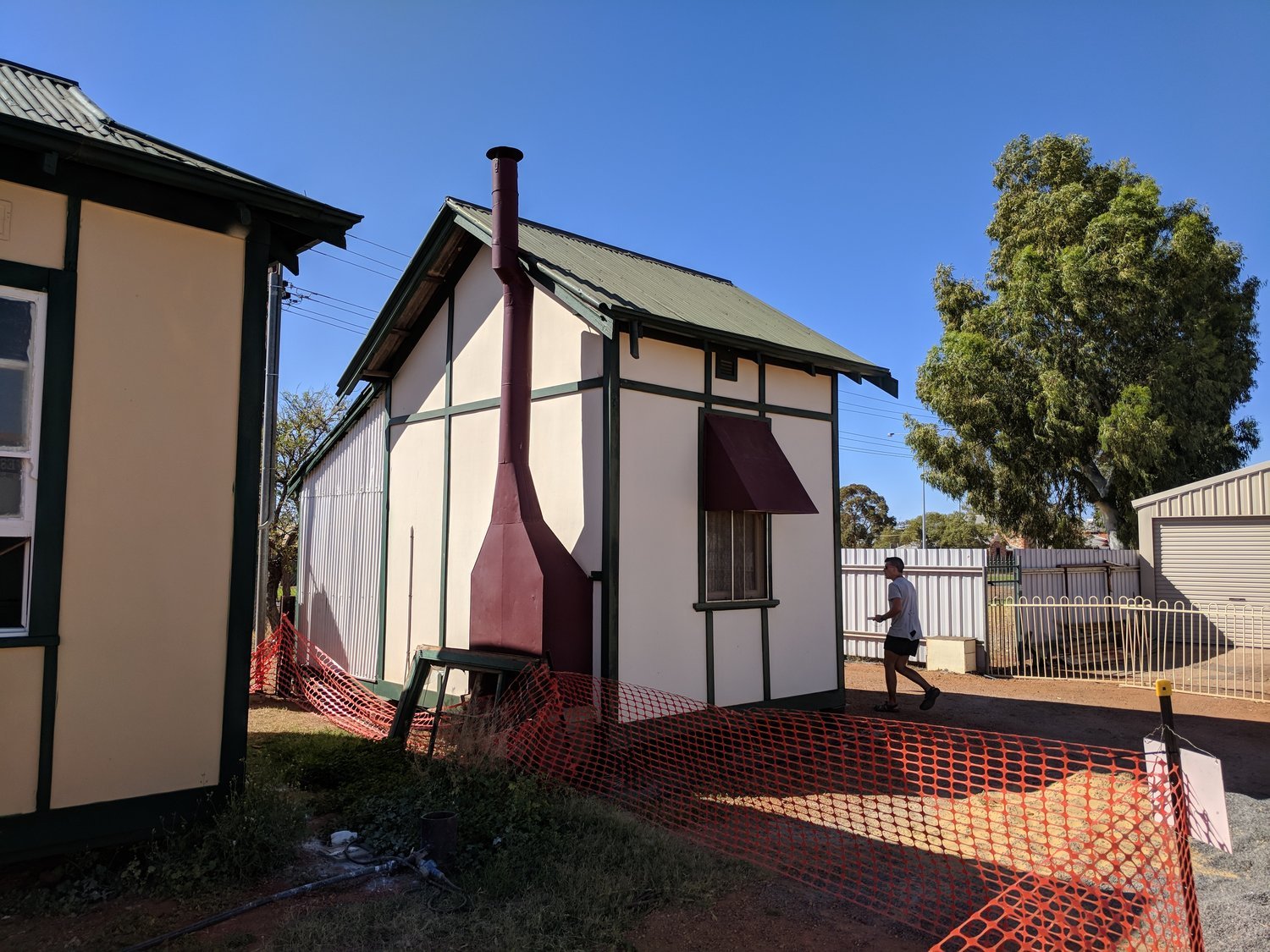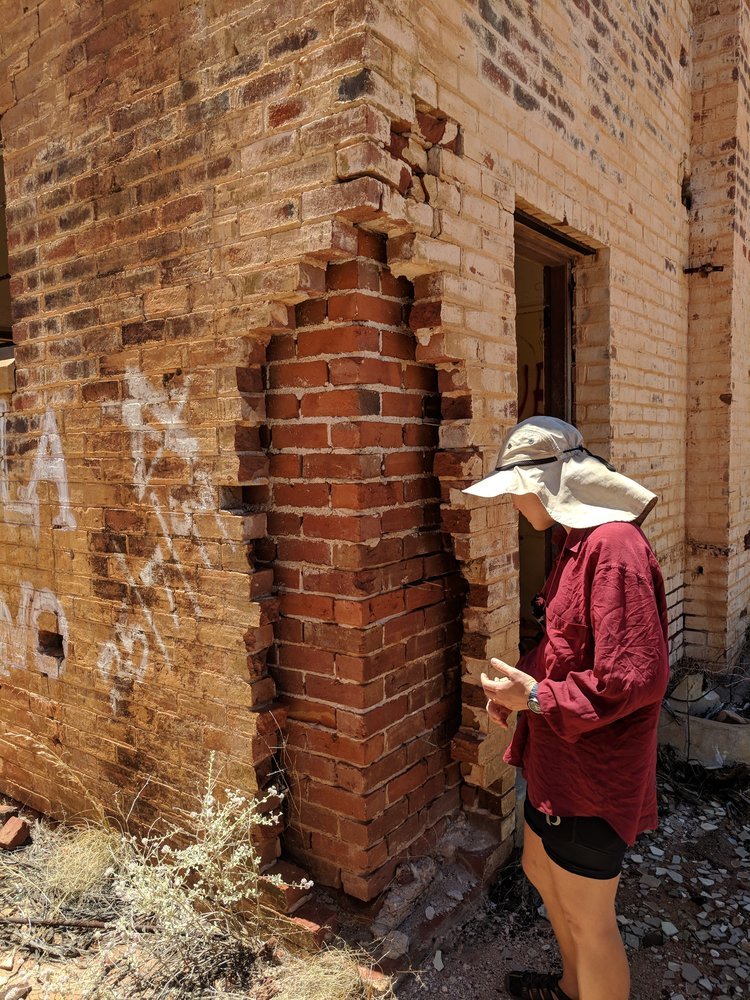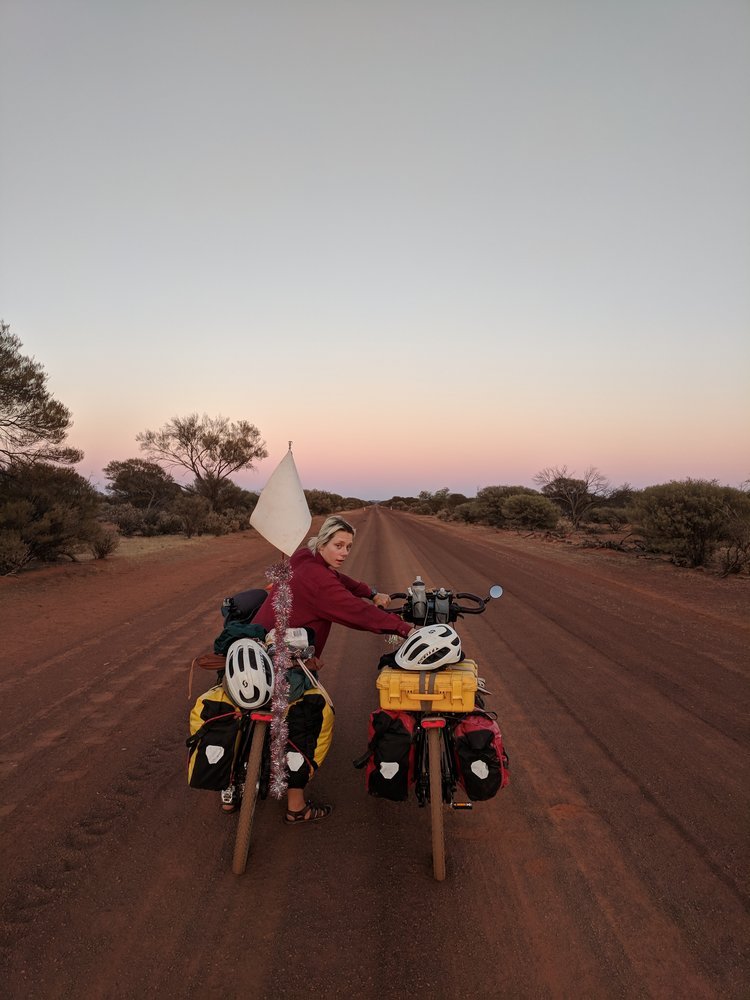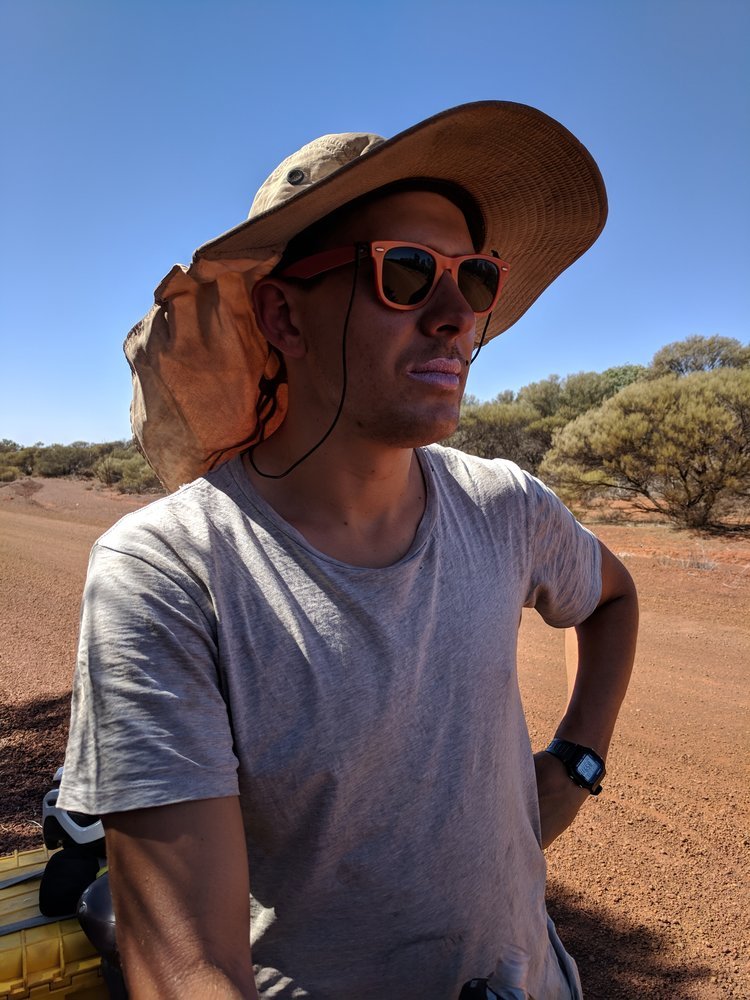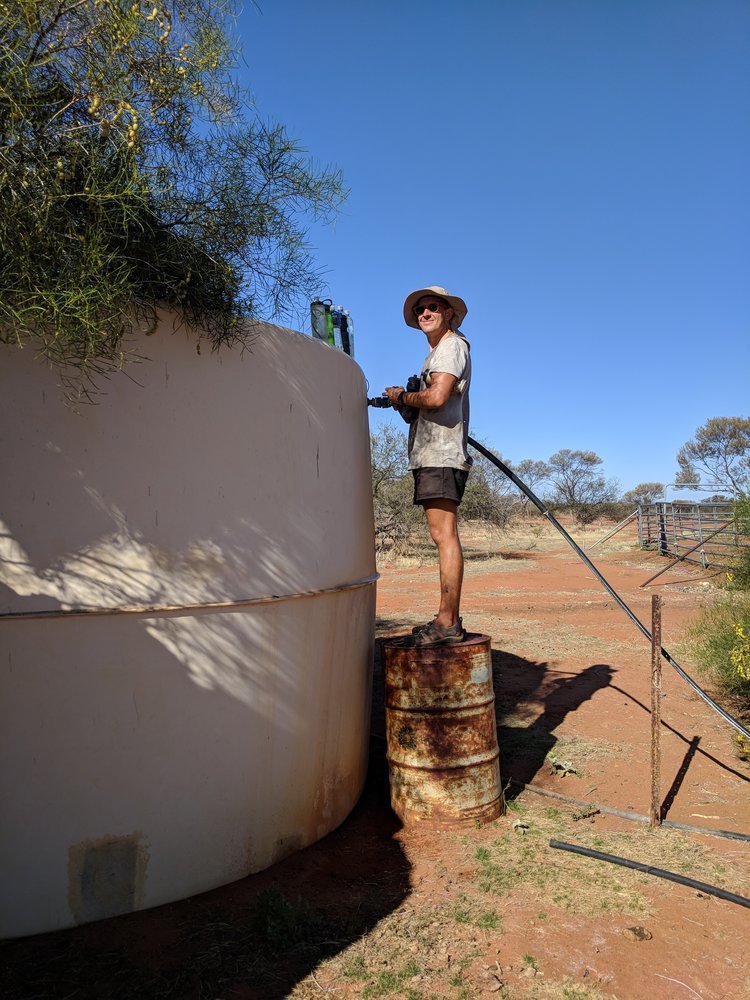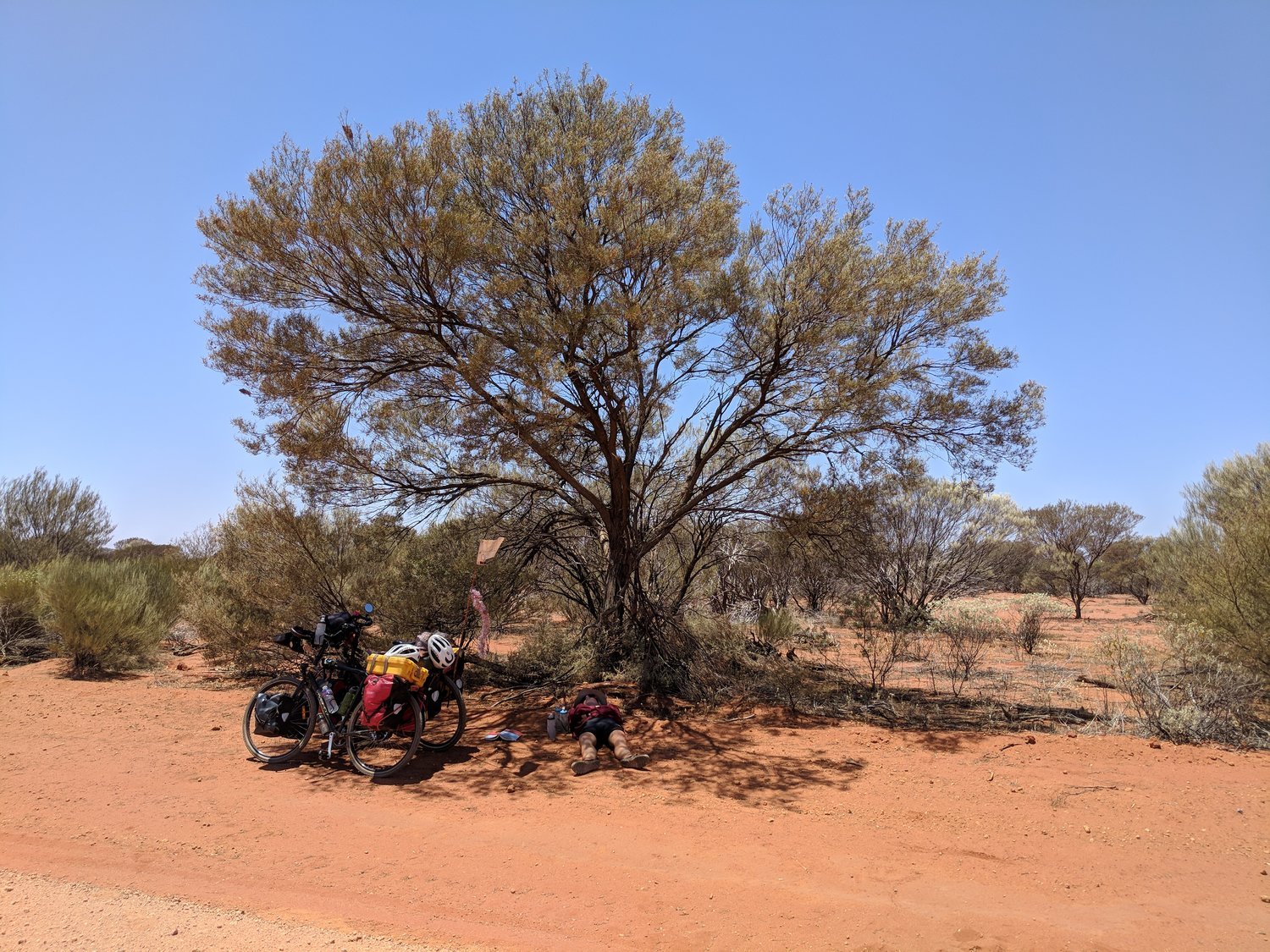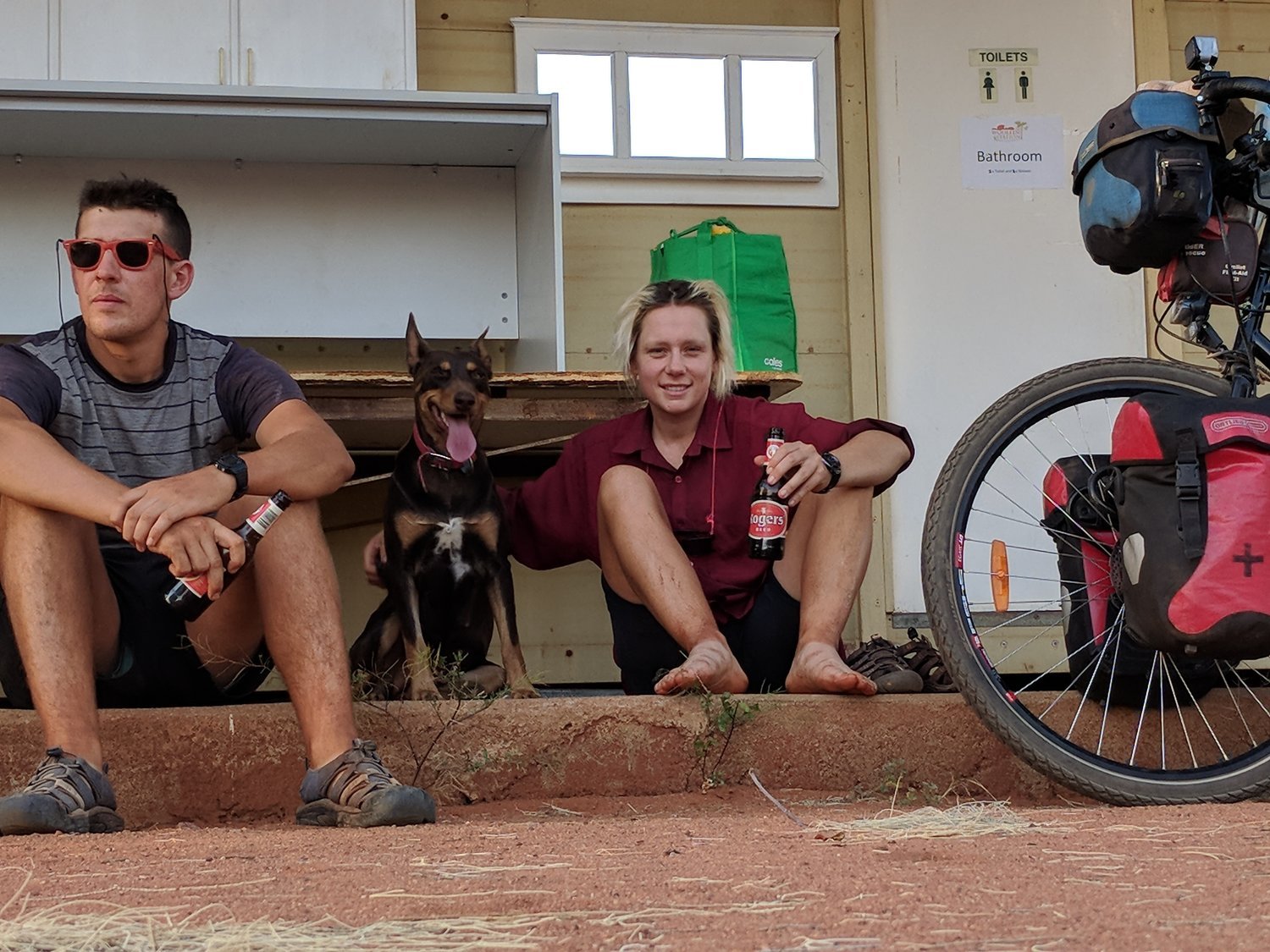The Grand Section Guardian #017 - Stop 17 Meekatharra/November 26, 2017
Surrounded by open cut mines, with the protective ring of ‘rehabilitated’ earth and small signs urging caution, Meekatharra still has significant deposits of gold, copper and ore to be dug. Meanwhile decade old gaping pits leave locals scratching their heads as to how to utilize these monumental sized constructions to leverage tourism, the scale of modern ruins. The administrative centre of the region, Meekatharra is certainly not for the meek.
PLACE
12th-29th October, 2017
Located on the edge of Tjupany and Watjarri lands “Meekatharra” apparently comes from the Watjarri word for “a place of little water” OR “a place of a little water”, a small but significant difference. The lands around Meekatharra are scattered with sparse mulga woodlands[i] that dot low hills and granite outcrops that are separated by flat colluvium (material which accumulates at the foot of a steep slope) and alluvial plains[ii]. Huge manmade mesa’s rise on the horizon above the flat scrub indicating monumental holes on the other side where gold, nickel, iron or copper has been dug out. Of a night, perpetual light separating the night sky and the ground plane indicates where digging is occurring. Sheep and cattle stations provide permanent inhabitation of vast chunks of the area. 300 year old sedimentary and volcanic rocks from the Archean period form the bed rock for this dry and dusty town in decline.
View over Meekatharra from the south-east. Standing atop the waste pile of unused Luke's mine (seen to lower right), the town lookout has found a home.
Located in the gold rich corridor that saw so many people flock to this area around 1900, Meekatharra is still a gold mining town. Not as much in practice but in the structure of the planning, housing and industries. The Great Northern highway follows a gold rich vein through the country side and brought so much of the early development to the area[iii]. The town still sits along the transport route, where it is not uncommon to have ‘oversize’ and convoys of 4 dog semi-trailers trundling through the main street.
Locals aren’t phased and somehow have come to sleep with the 24hr breaking and gurgling from the downing of gears through the town. We certainly found it hard to get used to.
SOME TRIVIA FOR YOU (courtesy of a local mine contractor at the pub) four x 4-dog-semis (4 trailers) come out of the local copper mine per day, each one is carrying $900,000 worth of product. That’s $3.6 million/day. Apparently they recovered all setting up costs for the mine in months. (Accuracy should be verified from a sober source).
Meekatharra is located on “Lukes Creek” which is an ephemeral watercourse only running after good rain. The Mikadah soak where the town apparently also gets its name is just down the road and was an important watering hole for the mobile tribes of the rangeland areas.
Another important “soak” is “Camel Soak” however this is an ephemeral waterhole which indigenous dreaming stories talk about and as part of their obligation to country would be dug out and cleaned to ensure it could be used when needed. This no longer happens.
Meekatharra is the ex-railhead, supply and administrative centre for the surrounding area of the rangelands. Only eight hours from Perth, Meekatharra is perfect stopping distance if you are driving up from Perth to Broome or elsewhere north and ‘a stopover’ appears to be what its existence has come to. At the turn of the 20th century gold was found at Meekatharra and in 1903 it was gazetted as a town. Sheep and cattle pastoralists took up large leases in the area and by 1910 a rail line had been put in with Meekatharra at its end to cart wool and cattle, this was in operation up until the 1970’s (peace and love man).
Today Meekatharra has all the history of a gold mining town although, very little of the industry actually feeds back into the community. A familiar story. Fly in and Fly out workers live in “camps” of dongas out of town, out of sight and out of involvement with the community. Three weeks on, one week off. Tourism is the new industry, aiming to capatalise on the golden history of the place there has even been a suspension bridge across an open cut mine site idea thrown around. As you dig a little deeper you find out that there are some radical acts hoping about town.
The pits around Meekatharra, photo taken before a bloke yelled "I am going to have to ask you politely to piss off"...
People
Anna Johnson (Made in Meeka)
Owner of Made in Meeka, purveyor and enthusiastic eccentric. Marking the corner of the highway and high street is this wild looking shop with hand-painted signs, stuff in the windows and a mo-ped out the front. Behind the counter (which is made to look like a trading post) sits a Canadian who arrived many years ago in a red bus, with no intention to stay. The rest is history…..and also a book (https://thewest.com.au/countryman/homestead/meeka-insights-a-worthy-read-ng-ya-112474). A cracker and highly satirical explanation of life in “Meeka”-tharra.
Much to contrary belief, Anna talks of the opportunity that exists in these remote towns. It’s a visceral experience of living where one has direct contact with all going-ons which generally the fear of red tape in a city restricts. From dressing local corpses, making personalized post stamps for the post office dog, rescuing dogs from open mine shafts and fighting fires with no training – you get it all. Anna was all for the Australian outback, sharing that if you are in any way motivated, happy to put up with the red dust and occasional lack of fresh produce you are able to have effective agency very quickly.
Community groups are often run by the same people who eventually burn out, so having a fresh face and enthusiasm is often welcomed. In terms of jobs…..well Anna says “if you want to work you can”. Anna has worked at the local road house, nursing home and everywhere in between but now, runs “Made in Meeka” (https://www.facebook.com/madeinmeeka/), which to her credit shy’s away from traditional tourist nick-nacks and tidbits which has oversaturated a lot of the towns we have been through. Instead it is crammed full of Meekatharra-centric postcards, paintings and even toilet rolls. Authentic to the place, bringing locals, their stories and their intricacies into the tourism propaganda, a real breath of fresh air. We even made it into her latest ‘The Howler’, Anna’s own satirical monthly newsletter.
Page 1 of the Howler, featuring yours truly - RHS column
Adelle
Adelle, we are sorry this is the best photo we had of you...we won't put up the ones from later that night!
The point of contact in many country towns is the CRC (Community Resource Center), full of info and a friendly face to point you in the right direction and often our first stop. So day one, we are met by a pom. Originally from Bristol, Adelle instantly wields the caustic whip of British humour unrelentingly. Illustrating the beauty of small town connections, she writes us a note of people’s names, where to find them and contact numbers if their hard to pin down. Subsequently running into her each day somewhere in town, she would add another name to the list or introduce us to a new face amongst the lettuce and pink lady apples. People like Adelle bring energy and new ideas to a town like Meekatharra, helping on several community groups and being instrumental to the ubiquitous annual race day. Adelle is an asset to the town and helps keep the community together. She is also currently sponsored for an Australian visa which mean she has to stay for three years. After that the town may lose a wonderful asset.
This is a common trend we have been seeing throughout rural Australia. Our inland is being cared for and run by foreigners, who seem to be the only ones interested in life beyond the edge. Maybe they have the right idea?
Svenja (meeka goes green)
Her story starts as so many do (note above)….backpacking. Working in the Meekatharra supermarket to earn some money to continue her travels this German backpacker ended up meeting a bloke and deciding to stay (she’s also included in one of the Meeka centric postcards). After failing math in high school and not even interested in a university degree it is clear from the outset though that Svenja is no dummy.
Hearing rumors of this trail-blazer from the hilarious info centre staff and about her grass roots initiative “Meeka goes green”. We decided to roll up our sleeves and attend the Saturday gathering to help recycle. Riding around to the back side of the council Depot we see piles of cardboard, plastic bottles and beer cans in ordered heaps to one side of a small corrugated iron shed. This is the local volunteer run recycling program, energetically done from 9-11 every Saturday morning. A radical initiative for these parts of the country, being no municipal recycling.
Svenja started this in 2015 with a small grant from the council to cover insurances, she and some dedicated volunteers started recycling in Meekatharra. A lack of recycling has been the norm in past towns and has left us pondering and questioning consumption. These folk are energetic with great intentions to change the conservative views towards waste which purvey these outback places. Most businesses are on board, collecting and depositing recyclables – cardboard, aluminum cans and plastics 1,2,4 are the extent of what they can do at the moment (“it’s a start at least” they say). They beg though for a viable option of dealing with glass as it continues to accumulate, litters landscapes and punctures tyres and feet. Not content to rest on her laurels her blog states she has an ever evolving plan to save the planet. Wacko! Below is video overview of it all!
Nigel
A local on the scene, we first encountered Nigel as we rode into town and devoured our chips and gravy. We eyed the bloke across the bar with the luscious mullet who was clearly a local by the way the other bloke behind the bar delivered drinks without only small hand movements as cues. Nigel is a jack of all trades who appeared to be able to do almost anything and each day for him seemed like a lucky dip of maintenance tasks for the local pub. Nigel is part of a dying race, country blokes who work hard, drink hard and eat red meat. In some ways the stereotype but we think that is a little shallow and Nigel belongs to the creed of fellas that above all are generous, trustworthy and go out of their way to make you feel at home. True country hospitality. Thanks Nigel.
Talking of people, we thought we’d add the damaging inner workings of FIFO life which has been brought to our attention and the worries surrounding the common male. Three weeks on, One week off means three weeks away from kids working huge days, isolation, remoteness, pressure on families and three weeks off the grog. The emotional taunting of this lifestyle establishes from such healthy incomes where mental and emotional health is disregarded and not a part of mine site inductions.
FIFO workers are at higher risk of suffering from mental health problems, 30% compared to the national average of 20%[iv]. If we’re concerned about healthy people and healthy places, buildings are a part of this equation. The effects of this ‘FIFO’ phenomena further more are directly relative to the degradation these remote towns are experiencing, being reflected through their ruinous states and broad disrepair. It seems, many people, buildings and landscapes are suffering.
Stuff (architecture)
Meekatharra hosts all types of inhabitation. Long before the ‘boom & bust’ of the mining resources that underpins the town today the indigenous inhabitation of this place was seasonal. Small, easy to construct temporary camps would grow from the available resources. Mulga windbreaks and shelters were common[v].
When permanent inhabitation resulted in a town, the buildings, such as the 1907 pubs are aspirational in size and workmanship of materials, hopeful of a prosperous future. Here to stay, regardless of FIFO. Today, mining is uncertain and employees no longer live in town, the buildings reflect these changes toward (or perhaps backward) to ‘impermanence’. Dongas and relocatable homes have become the norm, trucking in as required and easily relocated when needed. Seasonal prospectors, retirees & holiday-makers come and go, essentially nomads, these folks live out of vans, tents & caravans using communal living, kitchen and outdoor spaces. ‘Inhabitation’ is not limited to houses but includes all aspects of the built environment, permanent, temporary and even, big holes in the ground.
Colloquially known as Bunnings, “The Tip” is visible from some houses, “especially if it’s on fire” came the dry remark from a local. Its informality is its virtue, where locals not only go to hunt and salvage building materials but is also the destination to hunt Bungarra (Goanna) as they rummage through the unsorted, unrecycled waste. Many of the earlier buildings, typically constructed of asbestos have been wrapped and buried amongst the Bungarra’s and bent metals. A party really…
The Hardware store. Price match this one Bunnings!
Houses are not too dissimilar to what we’ve seen before, a lot of transportables and demountables. House prices can range from $30,000 - $180,000 with many vacant WA homes left vandalized and easy targets for the wanderers of the night. A recent indigenous housing complex has gone into the town, not able to get into one – we think the house design (from the outside) quite good in being made of durable materials and a central sealable breezeway acting as extra sleeping space and sheltered outdoor space. But, as we’ve seen before with the masterplan not going ‘to plan’ the designed communal kitchen space and outdoor spaces have not been successful due to the ‘ol’ feuding of separate families who weren’t meant to be living there together’ situations. Bringing into question the role of architecture, when should architecture attempt to create culturally appropriate spaces?

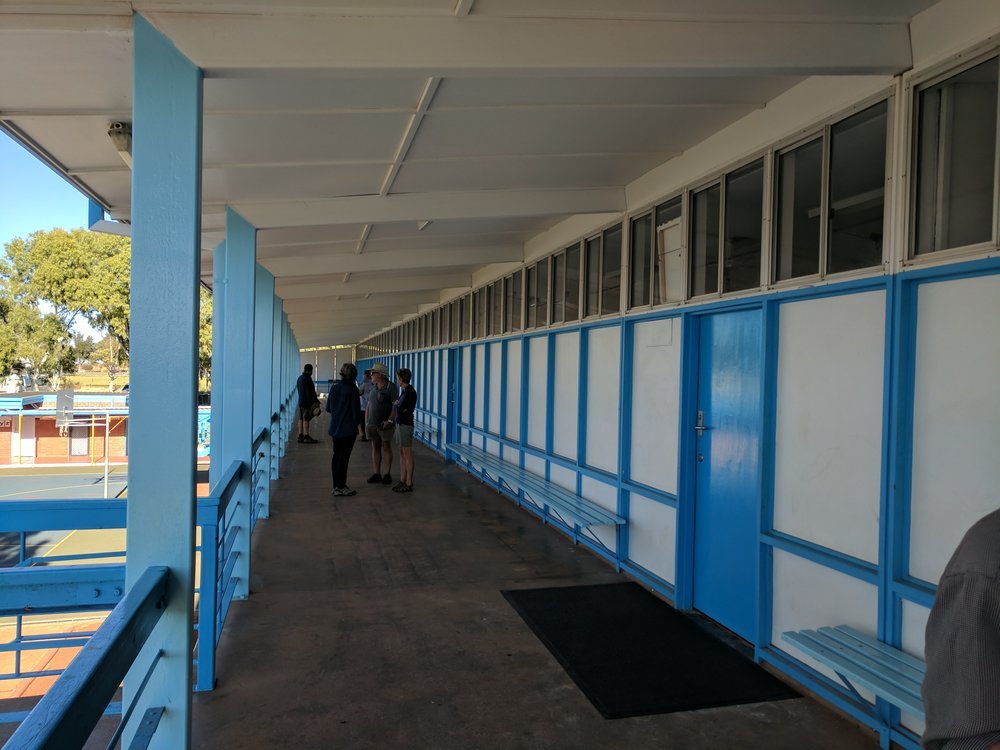

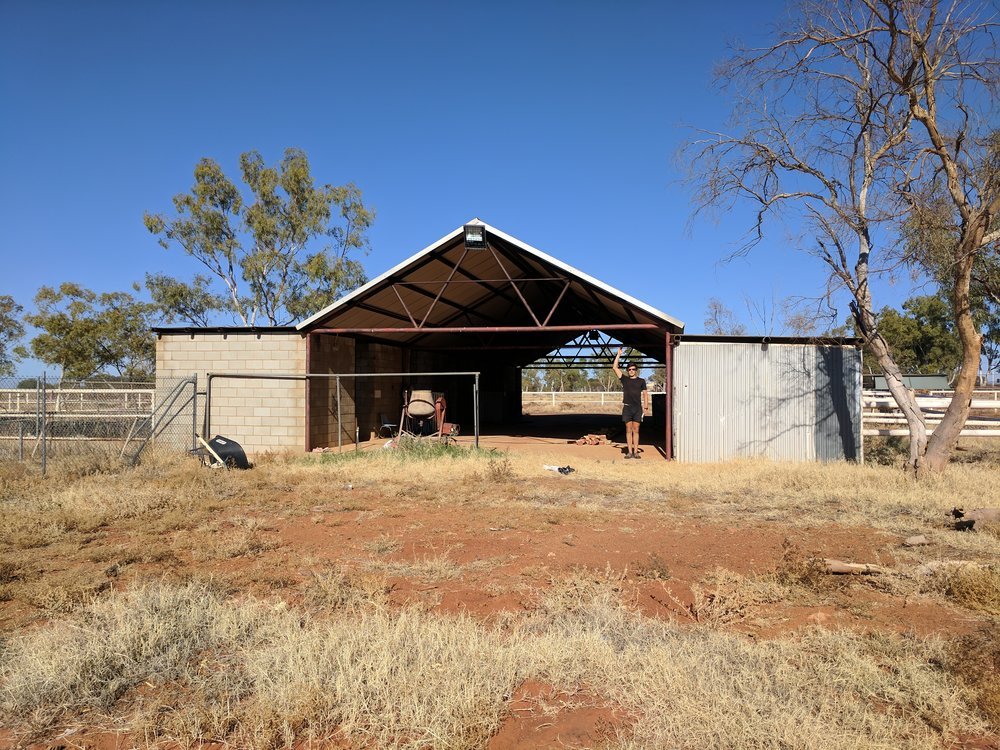
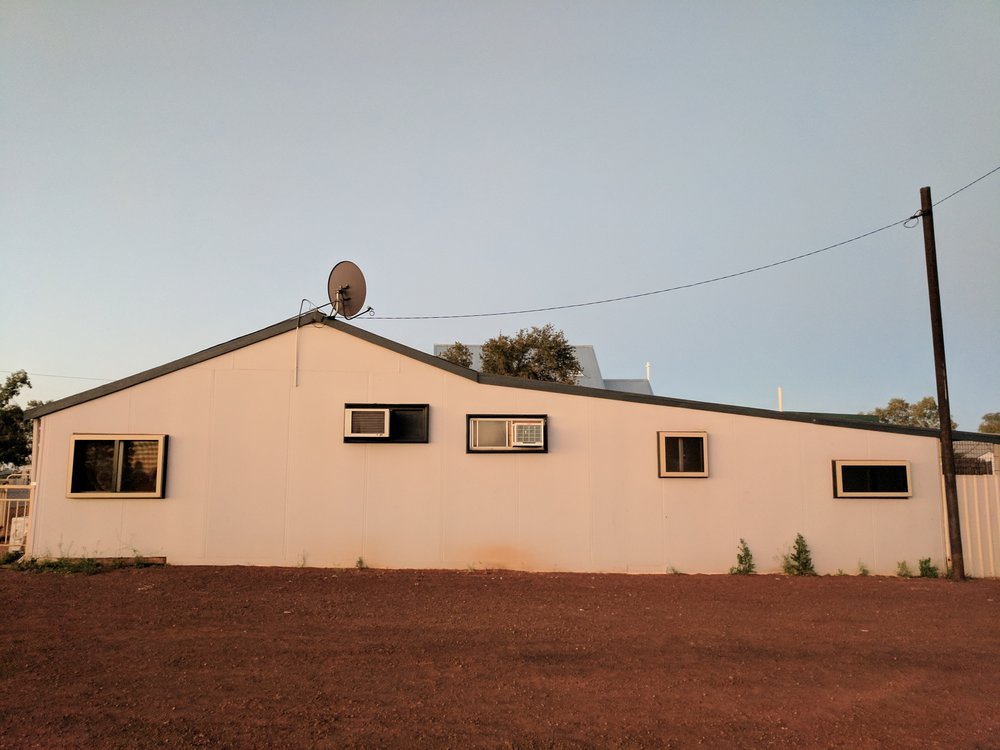
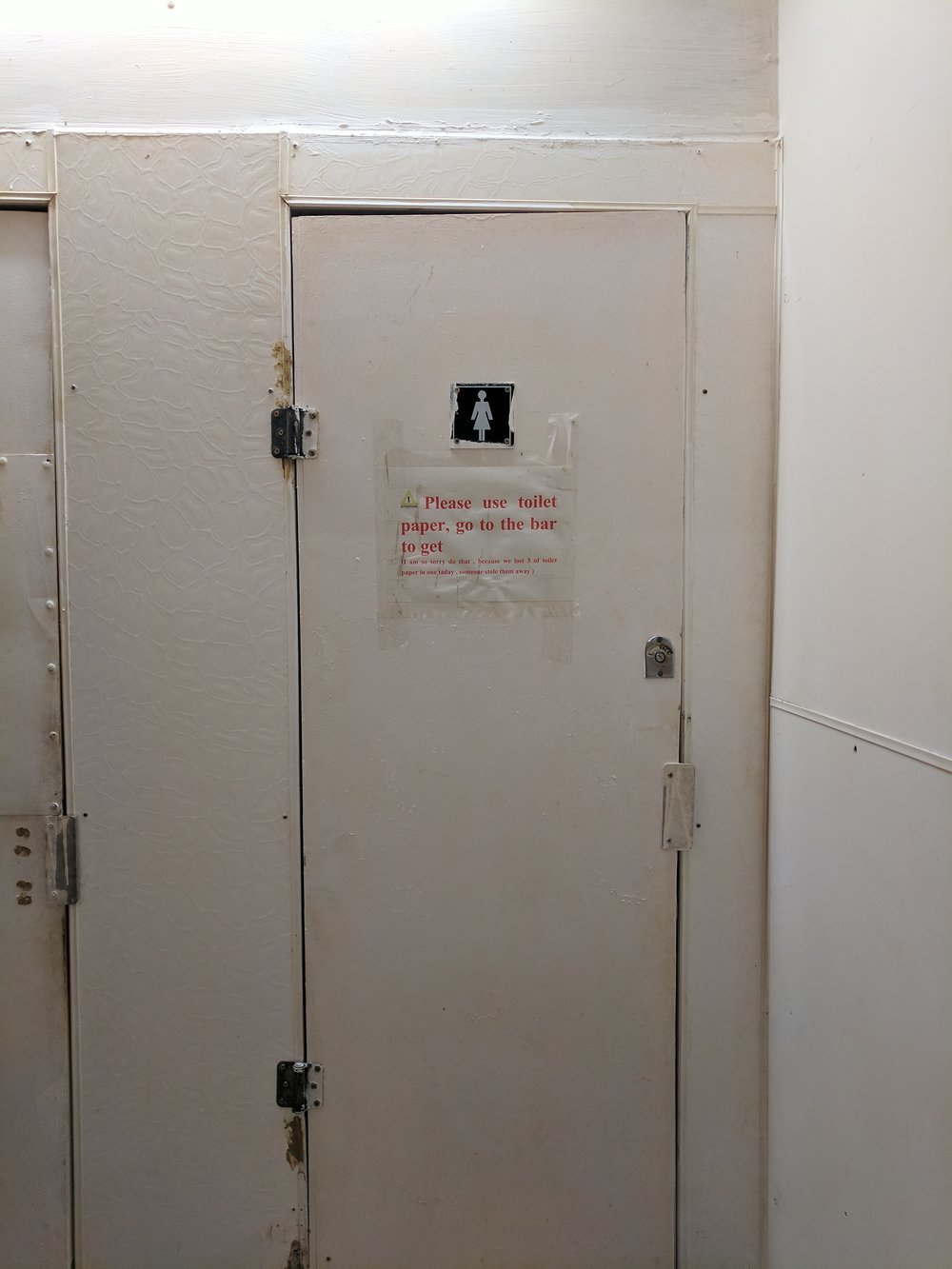
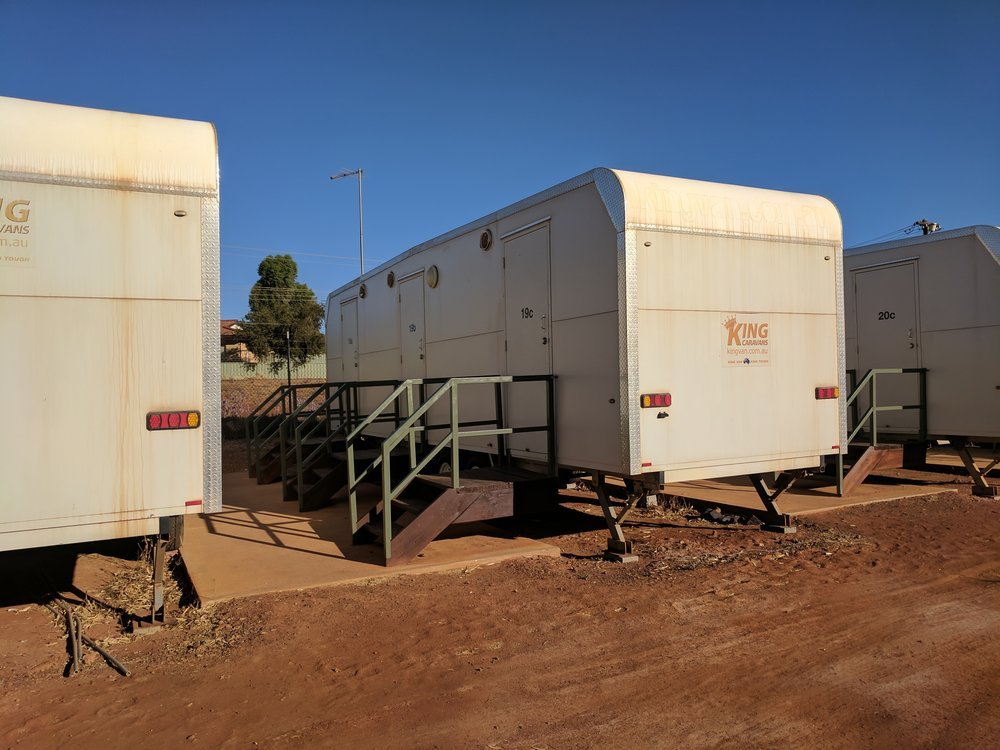
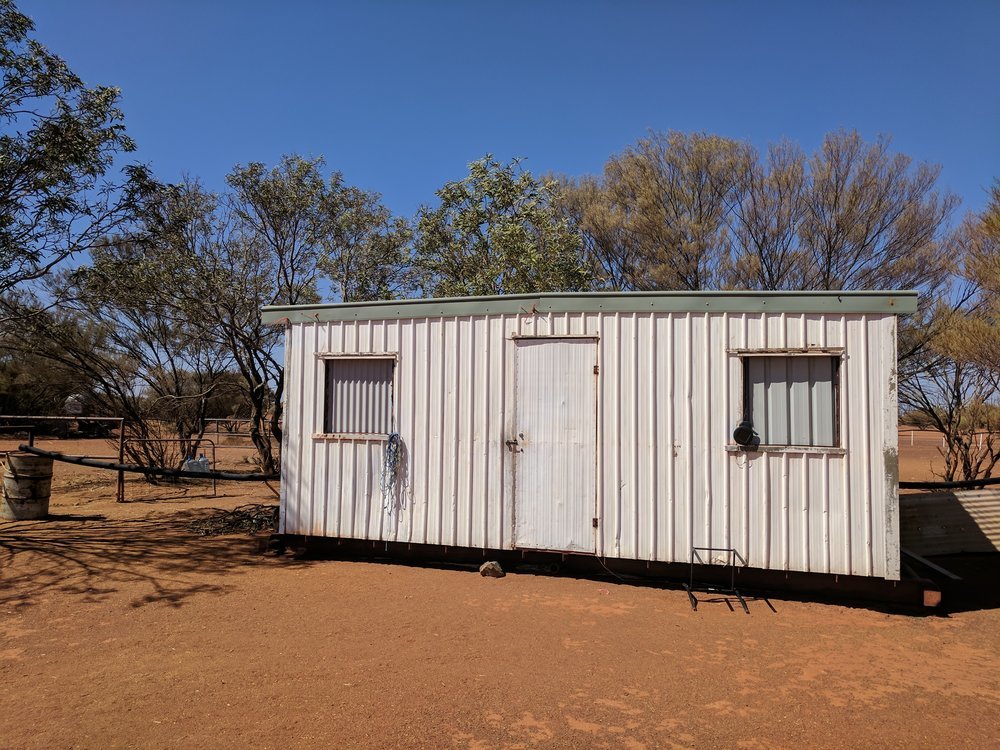

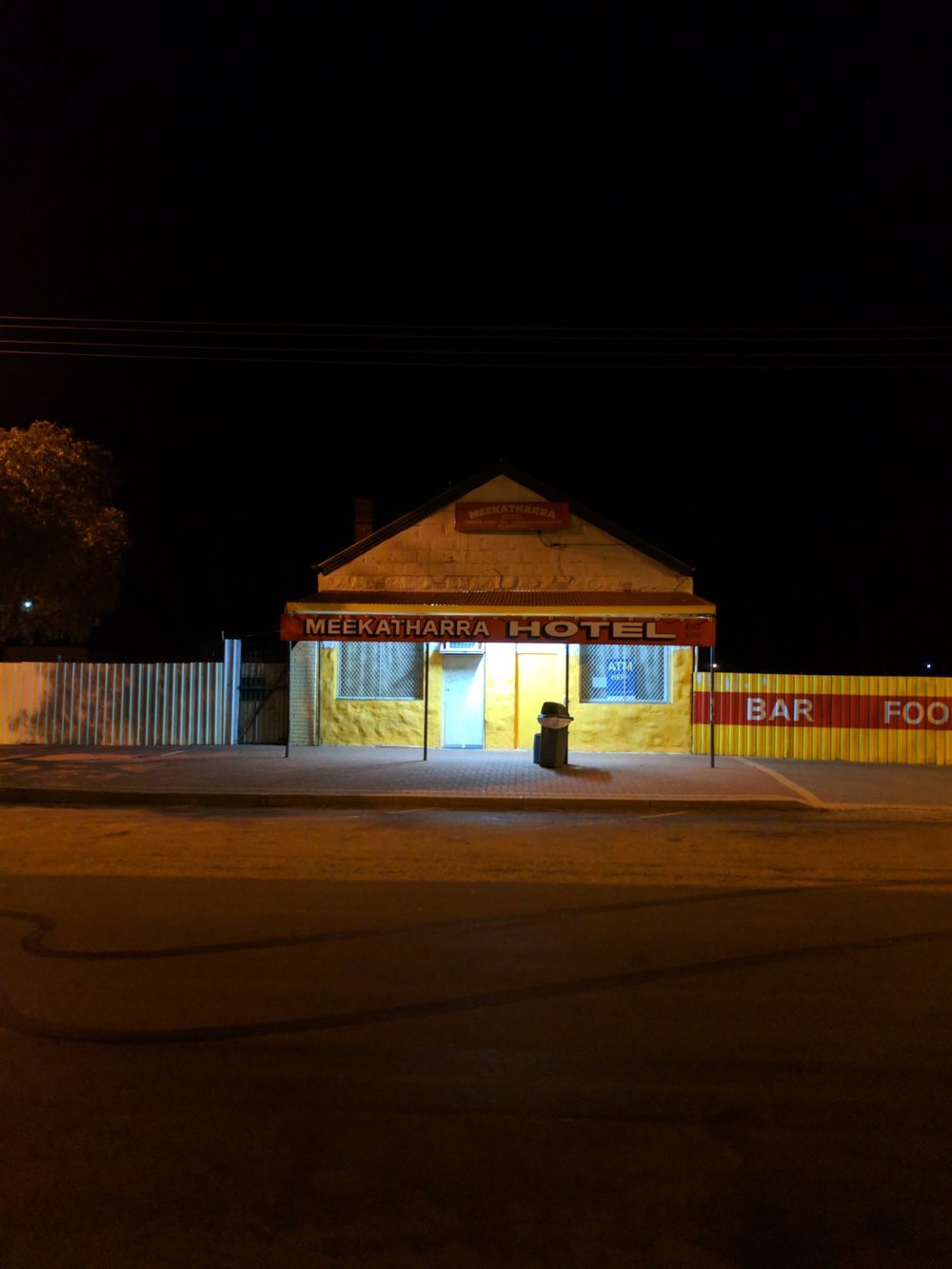

The most radical piece of architecture, sticking out like a sore thumb was by far The Food Van (http://energisecafe.com/). Parked on the prime intersection of town, the corner of two major street/highway frontages with parking out the front and palm treed park behind. Equipped with its own truck & generator, the café is completely self-sustaining using 2L diesel/hr. fuel, roughly $1000/month costs. 100L drinking water and waste water tanks, filled and emptied everyday with the highest quantities of water used during winter under the coffee demand.
This location came about as a result of the less than attractive assistance and options from the local council in renting out one of the MANY disused and barred window shop fronts. Being the most viable option, although radical and self-sustaining is not assisting the growing presence of abandoned main streets and breathing of life back into the otherwise falling down shop fronts and stores. Over and over we hear from locals of the need for greater incentives to get small business owners in, support and allocation of funding from local council for façade revitalisations and fit outs giving the town a new face and its people incentives to take up the spaces. Similar story to Laverton. Regardless of local politics, David wanted to create a healthier food option for many of the locals. As direct competition to the greasy pub food Energise is open late (till 11pm) providing an alternate and healthier food source for when centrelink payments are processed at 10pm. Know your clients.
Exhibition, Friday 20th & Monday 23rd October
Side of Food Van
Using already existing infrastructure and the best positioned café we think we’ve come across, with David’s permission the food van very quickly became the prime exhibition space. Learning of peak periods from David, 11-2pm it was! This covered the lunch goers and passerby’s, a sure audience…
This exhibition focused on the varying scales of inhabitation that are seen in Meekatharra. Houses, dongas, trucks, pubs, schools and mine pits these marks are all a part of the built environment and part of our broader foot print. Wielding drawings and scale models we studied comparisons of temporary and permanent inhabitation in scale and material properties. The perceived direction of a place often dictates the architecture.
Well, we had a few come by (mostly people we were expecting). Anna spent some time looking over it and calling over any local that walked by... “Hey Sandy, have you seen this!!??.. Come and have a look”. Some others thought we were flogging something and there are always the classic slowly step backwards nodding politely type. However, with those we did engage with it was great to discuss the varying scales of inhabitation and get local insights into town. Svenja even spent her whole lunch break with us!
The following Monday we re-presented to the local year 5 and 6 kids. We were inundated with questions and interest, most likely only due to the bribe of zooper doopers at the end for anyone who asked a question. Regardless, it worked. We showed a range of examples of ‘well known’ Architecture seeing if they were familiar with the kids. From the pyramids of roughly 4000 years old, the Parthenon at 2000years, Sydney Opera House at 66 years and some Health Habitat biogas toilets built in Nepal in 2010, the idea of retrieving cooking fuel from your poo caused quite a stir especially the fact we titled it ‘architecture’. We created discussion through our drawings, models and bikes in the classroom asking the kids if they’d prefer to live in ‘temporary’ or ‘permanent’ buildings and why. The answers are always enlightening.
Loaded up to present at the Meekatharra primary school.
By far, the best asked question was, “Do you sleep in the same tent together….?” *whole class giggles
Suggestions
· If building temporary structures, built with materials that can be, recycled, reused or bio-degrade. Better yet just go to the tip.
· Re-use old buildings breathing life into them even in the short term in the interim of their disuse. E.g. Renew Newcastle from Laverton Blog (INSERT LINK)
· Consider the lifetime of the building and how old it will grow to be. Whether permanent or temporary.
· Know how a building hits the ground. Especially if it is removable. What will be left behind?
· Stone speaks of a future. Invest in labour, invest in a place
· Aluminum and polystyrene are rarely inspiring and therefore rarely valued. Especially on their 30th birthday as they take up a new home in the tip.
· Facades matter, they talk to the street and the town. Parapets too.
· Rather than air-con, set your tent up near a creek and just go for a swim (sound advice from Meekatharra year 5)
· Forget your camp cooker - “You can cook a steak on the road it gets that hot” (more sound advice from Meekatharra year 5)
In-between (Meekatharra to Wooleen Station)
30th October – 2nd November (4 days)
Our stay extended to two weeks in Meekatharra to give us some much needed time to finish university work and a presentation for the National Student Conference (which we can’t unfortunately make Dec 01 so we’re sending in a movie presentation). We were lucky enough to have a test screening of this presentation at the unused “Meekatharra Picture Gardens”, thanks to a local; Emily. We invited a crew of people along we’d been engaging with throughout our time to have some nibbles and critique the movie. They even gave us a standing ovation! The best response – “I thought I’d be bored… and I wasn’t!!” An incredible experience to have a whole cinema to yourself with good people, food and wine and the stars above. A pleasure and a privilege. A big thanks to Emily and our new Meeka mates.
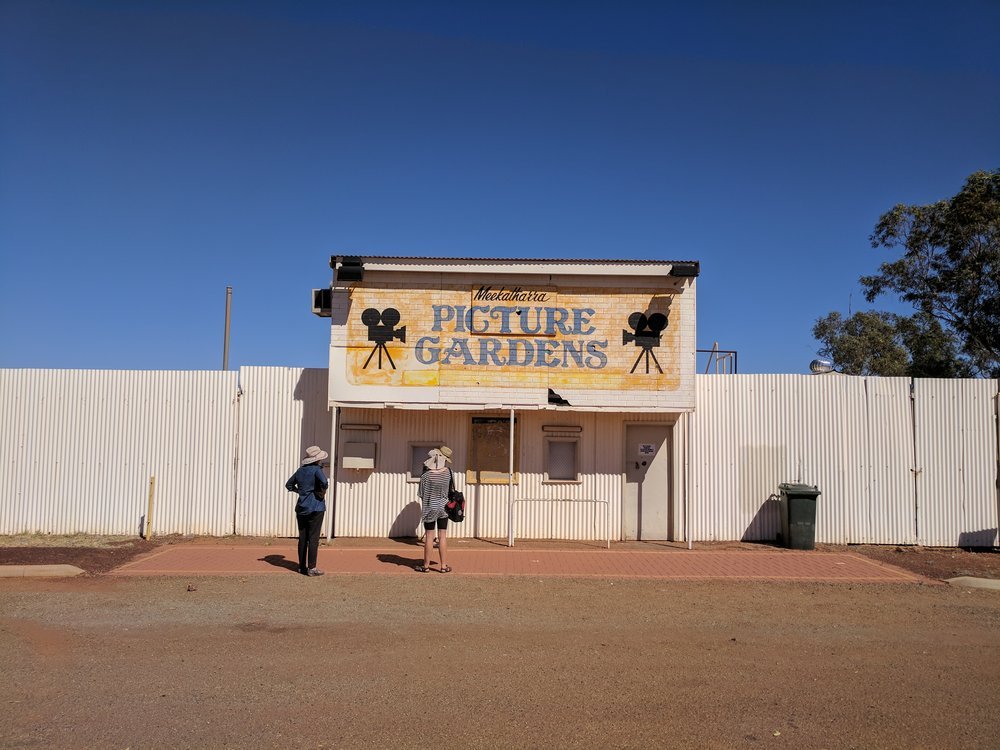
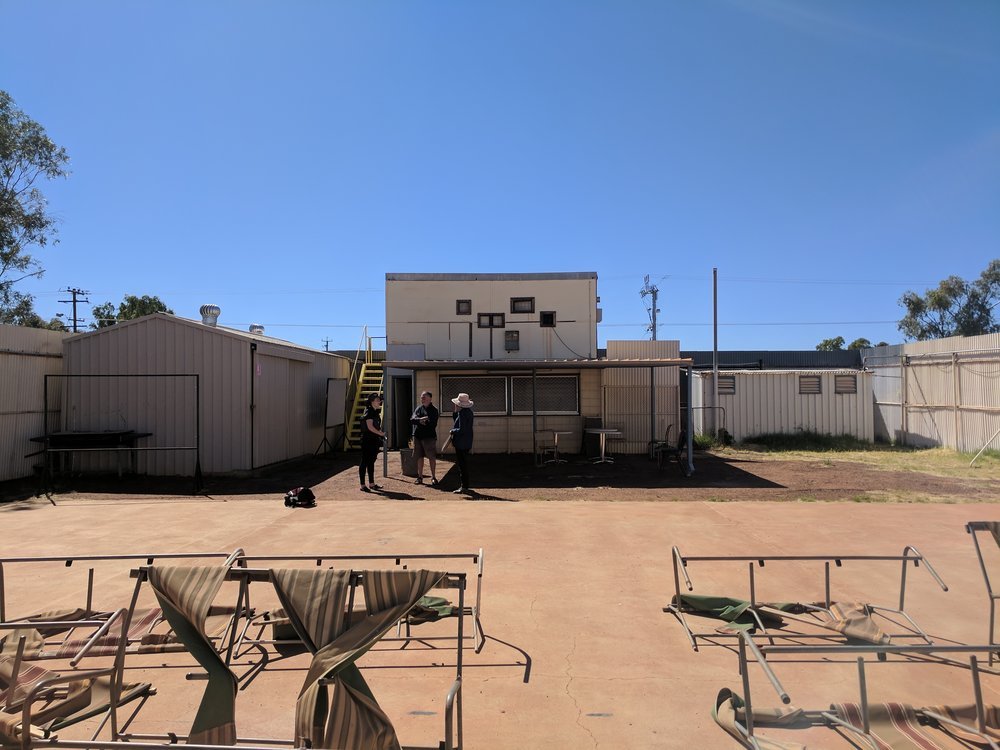
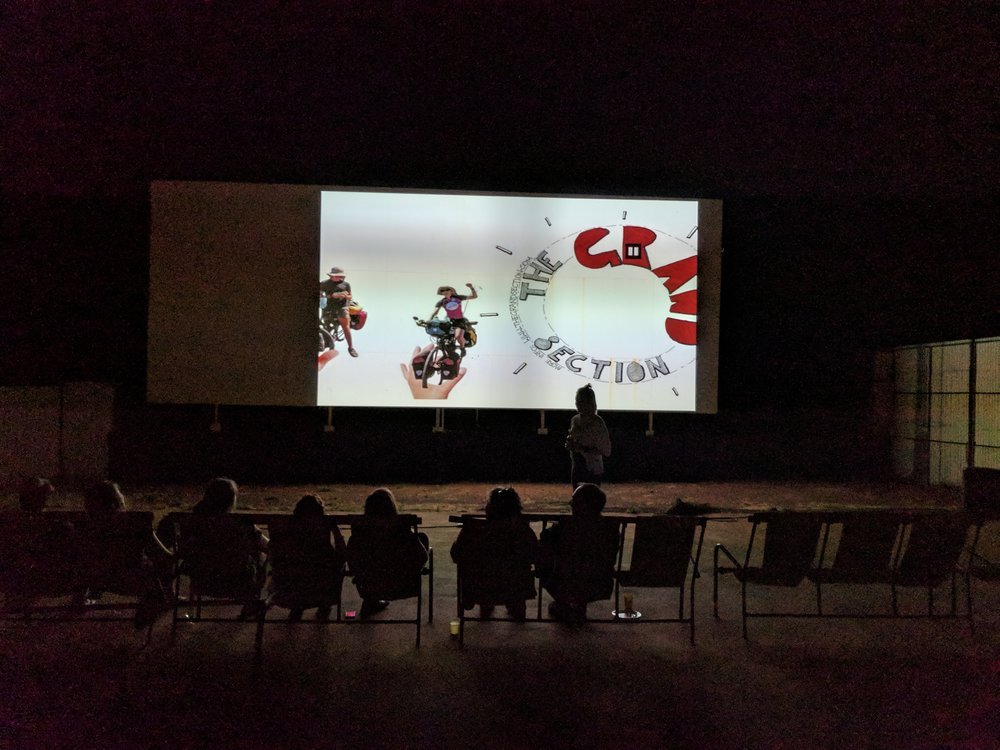
We were warned as we departed “it’s getting hot this week!”, and they weren’t wrong with it hitting 40 Deg each day of riding. Our hottest and thirstiest stretch yet. The carefully planned and rationed water plan we’ve been operating on was thrown on its head with us doubling our water consumption up to 10L/day, 9L of that for drinking. Riding from Meekatharra the upturning of earth didn’t fade out of the landscape until west of Cue. ‘Rehabilitated’ mounds disenchanting the landscape. Night 01 we landed on cue, in Cue, rightly named ‘The Queen of The Murchison’ the town is littered with stone buildings, a rare occurrence we’ve come to learn and reserved only for public aspirational buildings of administrative centres. Sadly, a similar story. A majority of buildings disused, un-maintained and abandoned with a dwindling population. Sad scene. We stopped into Big Bell too, a mining ghost town lasting a mere 19 years from 1936 to 1955 at the height of a resource boom. Incredible infrastructure built and now ruinous, the last remaining structure being the double height hotel, pillaged for its materials. We sat out for a few hours in the heat of the day under its generous verandahs, pushing away the rubble and glass chards for a cool piece of concrete.
Big Bell pub, now in ruins, once reputed to have the longest bar in the Southern Hemisphere. Not too bad for a town that only lasted 19 years. A stark contrast to temporary towns of today, we're yet too see a building of such grandeur.
It didn’t take long though for the feelings of disenchantment and landscape upheaval to retreat as we quickly became the only presence on some lonely old roads through what seemed, harsh back country. Barren red earth, stark, nude even on its ground plane. Shade a highly sought rarity for us, with the Mulga much smaller and leaf coverage sparse. We soon realized we weren’t alone as we began following fresh-ish camel tracks, scat and footprints walking alongside. Following these for 2 days we finally came across their camp as we rode into the cool of the night. Two renegades who have been walking for 10 months across the continent! Epic!
Over the 4 days we would rest often as the heat and hot wind was draining. Sapping energy from us quickly and furiously, we rode early waking up at 3am to get the hours in before sunrise. Sunrise at 5.30, by 7am sweltering sun beams burnt the skin. The landscape isn’t forgiving and the life-source (water) hard to come by. Many windmills and tanks empty, broken and brittle under the intense sun. Day 03 We found a working windmill powered bore, we were incredibly grateful for water cooler than our 35deg water. That stuff just doesn’t quench the thirst.
As usual, a headwind on our final day into Wooleen Station made us fight to earn an arrival. Fatigue had started to set in by that point. Overall exhaustion to be honest from the past 8 months of riding and momentum. To keep going it got to the point of counting down kilometers one by one, celebrating the reaching of each one. Counting the 385 reptile tracks we cut through on the dirt track gave some distraction, but also strong feelings of wariness.
The oasis, Wooleen arrived at the end of a red dirt track. Tall Palm and gum trees as usual, the mark of civilisation eased our worries and strain. We startled Frances, the owner wandering across the lush green lawn moving sprinklers – “oh! You’re early...” followed by a warm, hospitable and welcoming laugh. She gave us a beer each, we sat with the dogs and drank.
Edited by the incredible Jen Richards, we hope you are feeling better!
[i] http://austhrutime.com/mulga-woodlands.htm
[ii] https://www.environment.gov.au/system/files/resources/a8015c25-4aa2-4833-ad9c-e98d09e2ab52/files/bioregion-murchison.pdf
[iii] https://daciangold.com.au/company-profile/
[iv] Article: FIFO work can increase risk of mental health issues, WA parliamentary committee finds - mobile.abc.net.au
[v] Gunyah, Goondie and Wurley, Paul Memmott, 2007

